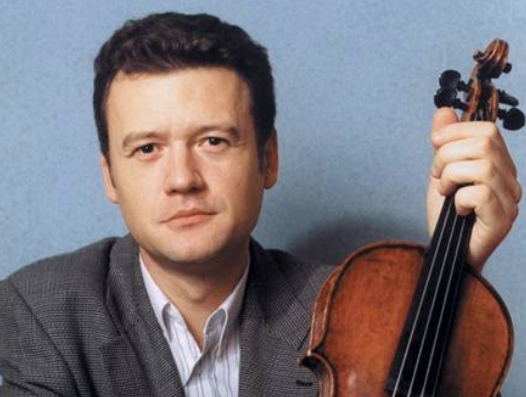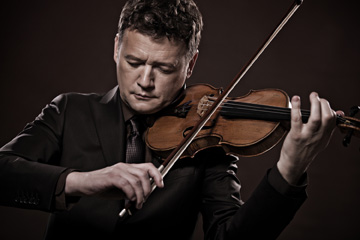Ivan Ženatý, violin
Weill Recital Hall at Carnegie Hall, New York, NY
April 4, 2018
For the 333rd anniversary of the year of J.S. Bach’s birth, Czech violinist Ivan Ženatý presented three selections from the celebrated Sonatas and Partitas for solo violin (BWV 1001-1006). He offered two partitas (No. 3, BWV 1006 and No. 2, BWV 1004) and one sonata (No.1, BWV 1001) in a program played without intermission or significant pause (more about this later). It was to prove to be a night of profundity and artistry that held the sold-out Weill Hall enthralled.
Mr. Ženatý (www.ivanzenaty.com) is what one might call a “throwback.” In today’s world, where many performers resort to “shock and awe” tactics with edgy wardrobe choices and brashness, often with a heavy dose of histrionic gestures, it is refreshing to see a performer honoring the traditions of days past. Dressed elegantly in white tie and tails, Mr. Ženatý has a regal bearing that exudes confidence, but without arrogance. There are no mannerisms to draw attention to himself; rather, he is a faithful servant of the music, investing in it his full attention and energy.
Written in 1720, the Sonatas and Partitas are models of the violin’s technical capacity as a solo instrument, and they have become an essential part of the violin repertoire. Georges Enescu considered them “The Himalayas of violinists,” and he recorded all the sonatas and partitas in the late 1940s. Perhaps more relevant to this evening, though, is mention of Josef Suk’s recordings and performances of these very works, as Mr. Suk was among the important mentors of Mr. Ženatý. It occurred to this listener at several points in the evening that his influence was discernible in matters of tone and artistry – both exceptional.
Opening with celebrated Partita No. 3 in E major, BWV 1006, Mr. Ženatý established his command immediately. The quick dynamic changes in the Preludio were flawless, and without any loss of sonority or tempo. Particularly beautiful were his softer passages. So many string players lose the quality of projection when playing softly – or worse, in amateurish cases, slow down! – but Mr. Ženatý demonstrated an effortless mastery with no such issues. His ornaments were delicate without being brittle or strained sounding, and he never rushed in the lively movements. He showed a flexibility of phrasing and elegance that were just what was needed for the courtlier dance movements, with exemplary clarity and crispness of articulation.
Throughout the evening, it should be noted, Mr. Ženatý’s intonation was always precise and his bow work exquisite, without any hint ever of scratchiness. One can only hope that, in his capacity as a teacher (on the faculty of the Cleveland Institute of Music and elsewhere), he can impart his secrets to the next generation! It doesn’t hurt that Mr. Ženatý plays a 1740 Giuseppe Guarneri del Jesu violin, courtesy of the Harmony Foundation of New York, but naturally even such a violin doesn’t play itself!
Following the E Major Partita was the Sonata No.1 in G minor, BWV 1001. Played incisively throughout, with careful attention to the smallest of details, it was a virtual masterclass on how to play this work.
I must offer one serious criticism, not about the quality of Mr. Ženatý’s playing, but that he did not allow sufficient time between works for the audience members to “reset” their ears. This listener needs the sonic equivalent of a glass of water (i.e., a moment of silence), and while the violinist might have not wished to lose his momentum, it was apparent that some in the audience were not even clear about where in the program they were (as was evidenced by the lack of any applause until the complete end). Leaving the stage for just a moment would have solved all issues, and I am a bit surprised that such an intelligent musician failed to avail himself of this simple action.
The Partita No.2 in D minor, BWV 1004, with its epic final Chaconne, ended the program. This Chaconne, in the right hands, is always the pinnacle of a program, and as much as one had been mesmerized by the playing throughout this concert, including the beautifully played earlier movements of this Partita – especially the Sarabande – one could feel the anticipation building right up through the Giga that precedes it. Yehudi Menuhin called the Chaconne “the greatest structure for solo violin that exists,” and Joshua Bell has said the Chaconne is “not just one of the greatest pieces of music ever written, but one of the greatest achievements of any man in history. It’s a spiritually powerful piece, emotionally powerful, structurally perfect.” It is indeed all of the above, but it takes a violinist of the highest order, and Mr. Ženatý fit the bill. He not only did not flag after the preceding works but, on the contrary, he seemed to be even more energized and focused than during the rest of the evening. He took a deep breath before launching into it, and it was clear that he was embarking on an unforgettable journey. His conception was breathtaking, and no detail was amiss in the realization of it. One was left simply awestruck.
The audience (finally!) responded and gave Mr. Ženatý an immediate and richly deserved standing ovation. Shouts of Bravo! beckoned Mr. Ženatý to return to the stage four times, perhaps hoping to coax an encore. After the monumental Chaconne, this would have been akin to popping open a can of beer after eating at a three-star restaurant. Of course, Mr. Ženatý did not do that, but took his final leave with the Chaconne’s last notes still resounding in one’s ears.
There are not many chances to hear a violinist of this caliber live – music lovers who have the opportunity to hear Ivan Ženatý in future performances should not hesitate to go.


